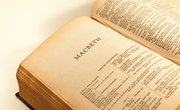Many of today's great works of art – whether they are works of literature, movies or symphonies – use a variety of compositional tools to create a multifaceted meaning. These tools can be symbolism, metaphor, allusions, well-known quotations and a variety of other recognizable strategies and devices. They work together with the artwork’s main idea to illuminate a deeper universal meaning for the audience. That deeper meaning is called the theme, which is the backbone to all great works of art and literature.
The theme statement is a sentence or two that defines the theme of the piece of art, entertainment or literature. The theme is the subject of a piece, but it should not be confused with the main idea or plot.
What Is a Theme?
The theme is the big idea an author is trying to convey. This may sound complicated, but it is a concept that you run into on a daily basis. Themes are easier to see and recognize than the concept is to define.
The easiest way to think about the concept of the theme is to ask yourself this question: What concept was the writer (if you're studying a work of literature) trying to express with her story? The concept we are talking about here is not the plot. Instead, it is more of a universal message, one that would be recognizable to the average reader given the interplay of the plot and other story elements.
Sometimes the theme of a work of literature can be summed up with just a word like love, loneliness or death. A work in which a theme can be summed up so succinctly generally offers an exploration of that idea, expanding on it by using many aspects of that single concept.
Other works can have more complex themes, such as the alienation created by technology or the impact of gender roles on society. These works might offer various tableaux that explain the author’s point of view on that subject while still maintaining the plot.
The options authors have for themes are endless. While many authors attempt to incorporate a grain of universal truth with their theme, most do not begin writing with a set theme in mind. Instead, they endeavor to tell a story and allow the theme to develop over the course of the story’s writing.
What Is an Example of a Theme?
"The Great Gatsby" by F. Scott Fitzgerald is a book with multiple themes. If you have read the book, you probably remember that the titular character, Gatsby, has been pining for Daisy Buchanan for years. It would not be off base to say that one of the novel’s themes is love. A student could also interpret the same aspects of the novel as contributing to a theme of unrequited love or heartbreak.
The most famous theme of "The Great Gatsby," however, is the American dream. In Fitzgerald’s day and well into the 21st century, the concept of the American dream was often defined by achieving financial independence. It was the attainment of the proverbial house with the white picket fence.
However, if you have read the book, you know that Fitzgerald's famous novel does not praise the American dream – it criticizes it. Striving for wealth and other things he did not have ultimately lead to Gatsby's tragic downfall. The way the plot works together with the novel’s major images and symbols shows that “the downfall of the American dream” is the novel’s most important theme.
The most famous theme of "The Great Gatsby," however, is the American dream.
What Is a Theme Statement?
The theme statement is a sentence or two that defines the theme of the piece of art, entertainment or literature. Theme statements tend to be used in discussions regarding that work of art or literature, but the most common times you are likely to find them as a student is either when you’re reading a descriptive analysis of that work of art or literature or when you are writing a descriptive analysis (like a report or paper) yourself.
A theme statement usually states the work’s theme succinctly, allowing for elaboration as the discussion or paper goes on. In this way, a theme statement can act as a thesis statement, preparing the reader or listener for the rest of the journey through the analysis of that work.
What Is the Purpose of Having a Theme?
Themes often develop even when the author or artist isn’t actively thinking about making them. Since defining a theme is often used to sum up the focus of a work of literature, works of literature that are well formed and developed will almost always have one or more themes.
For readers, understanding the theme of a work can help the reader to appreciate that work’s deeper meaning. Themes also allow authors to comment on humanity or society without being too obvious or on the nose. There is an old adage for writers: Readers like to work for their supper. If the larger theme of the work is too conspicuous, the work as a whole may come off as trivial or too simple.
Working to understand a work’s theme also gives readers a chance to flex their comprehension muscles. Interpreting a work’s theme requires reading between the lines and using critical thinking skills to decipher the author’s message from the text’s connotative meaning.
Understanding Themes Through Titles
After you understand the background of a story, do a prereading exercise. Look over the story, starting with the title. Is the title symbolic? Of what does the title remind you? Make a note of that. Titles are especially important in analyzing themes because many authors use them as clues to help the audience interpret the story.
Look for common symbols:
- ("Lonesome Dove" by Larry McMurtry),
- allusions ("East of Eden" by John Steinbeck)
- and quotations ("For Whom the Bell Tolls" by Ernest Hemingway).
If you discover hidden meaning in the story’s title, keep that meaning in mind as you continue reading. Write down every quote from the story that supports the title’s symbolism as the theme of the story. Don’t force it, though. If you can’t find anything to support the theme you discovered in the title, you may have to use a different interpretation for your theme.
Analyzing Stories for Theme
After you have pondered over the title, read the story once for understanding. Jot down your first thoughts on reading it. What do you think the story is about? What do you think the author is trying to say?
After you have written down your first impressions, go back and read the story again. Write notes in the margins (if you can) to help keep track of your thoughts. Look for symbols and motifs. These striking images and repeating patterns will point toward the author’s meaning. For example, if the author repeatedly uses images, like crosses and doves, that remind you of Christian symbolism, then the author’s theme may be religious in nature.
If you’re lucky, your story may have what’s called a “mouthpiece character.” A mouthpiece character is a character who voices a strong opinion and may speak at length about it. If the character is a true mouthpiece character, his speech will reflect the author’s opinion, and it may well clue you in to the story’s main theme.
Whenever you think you may have discovered the theme, it is important that you find other evidence from the text to support your hypothesis. Well-written stories will have many parts that echo the theme.
If you find that the story’s symbolism, characters, plot, motifs, language and message all connect along the lines of a single idea, you’ve found your theme.
How to Find the Theme of a Short Story
To find the theme of a short story, first do some background research. Find out who wrote the story, when it was first published and what type of story it is. Knowing this background information will help you immensely in discovering the story’s theme. This is because many genres of story have the same themes.
For example, many horror stories have death as a theme. Certain authors also use the same theme throughout many of their stories. Many O. Henry stories use situational irony to comment on an aspect of society.
Themes also go in and out of fashion, so certain stories from certain time periods may share the same theme. This is especially true of works published during historical periods when the influence of religion permeated all aspects of society. Stories published in these times will often rely heavily on morality lessons, and their themes will reflect such sentiments.
How to Find the Theme of a Poem
Finding the theme of a poem can be trickier than finding the theme of a story, but you can use the same strategies to get the job done. Consider the poem’s:
- background,
- title,
- symbolism,
- figurative language
- and message.
Just like with a story, the elements of a poem will all work together to contribute to one or more themes.
One strategy you can use to find the theme of a poem is to make lists.
- After you have read the poem through once, brainstorm a few ideas of potential themes.
- Make each theme idea the heading of a list.
- Now go through the poem to find elements, such as allusions or images, that would belong in each list.
The longest list will represent your major theme.
How to Find the Theme of a Movie
Did you know that movies have themes too? This is the kind of theme you probably have the most practice talking about. If you’ve ever tried to convince your friend to see a movie, you most likely mentioned the theme without even knowing it.
The theme of a movie is the deeper answer to the question “What is the movie about?” If you said, “It’s a romantic comedy, but it’s really about friendship,” then friendship is that movie’s theme.
Most movies don’t require deep analysis to understand their themes. Many boil down to universal ideas like:
- family,
- friendship,
- bravery
- and others.
Look at the actions of the main characters, especially toward the end, in order to identify the movie’s theme. Some movies, however, are more complicated. For more artistic movies, you can identify their themes using the same strategies you use with literature.
How to Write a Theme Statement
To write a theme statement, you should first discover the theme of the work you are discussing. Perform a complete analysis of the work before you begin to discuss it or write about it.
A theme statement can come in many forms. Above all, your theme statement should be easy to understand. It should state the title of the work, its author and one clearly defined theme. The best theme statements work like thesis statements, succinctly defining the attributes of the work that back up your interpretation of the theme.
Here is an example theme statement:
It is clear that the death of the American dream is the most important theme of "The Great Gatsby" by F. Scott Fitzgerald because Gatsby represents the American dream, and striving for wealth and success ultimately caused his tragic downfall.
Related Articles
References
Writer Bio
Rebecca Renner is a teacher and college professor from Florida. She loves teaching about literature, and she writes about books for Book Riot, Real Simple, Electric Literature and more.










